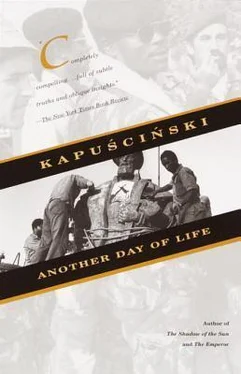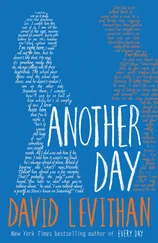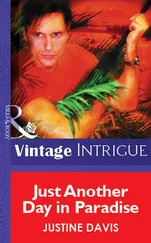That evening, to Warsaw:
I RETURNED TODAY FROM THE SOUTHERN FRONT, THE BORDER OF WHICH NOW RUNS ALONG THE CUVO RIVER. I WILL LEAVE THE DETAILED DESCRIPTION FOR LATER: NOW I WANT TO SEND THE BIG NEWS. THE WAR IN ANGOLA HAS CHANGED IN CHARACTER. UNTIL RECENTLY IT WAS PRIMARILY A GUERRILLA WAR, DOMESTIC, FOUGHT WITH LIGHT WEAPONS. THE INTERVENTION OF THE SOUTH AFRICAN ARMY HAS CHANGED THAT. TODAY THIS IS MORE AND MORE A WAR OF REGULAR ARMIES AND HEAVY EQUIPMENT. THE YOUNG REPUBLIC REMAINS IN A DIFFICULT MILITARY PREDICAMENT, BUT IT HAS A CHANCE TO DEFEND ITSELF. THE ANGOLAN ARMY LEADERSHIP IS CONSOLIDATING ITS FORCES TO GO ON THE OFFENSIVE.
SOMETHING ELSE FOR THE FOREIGN DESK.
MICHAL, RYSIEK HERE, LOOK, MY MONEY RAN OUT LONG AGO AND I AM BARELY ALIVE. IT IS MORE OR LESS CLEAR WHAT WILL HAPPEN, WHICH IS THAT THE ANGOLANS WILL WIN, BUT IT IS GOING TO TAKE A WHILE AND I AM ON MY LAST LEGS. SO I ASK YOU TO GIVE ME PERMISSION TO RETURN HOME. A PLANE IS SUPPOSED TO LEAVE FOR LISBON, AND IT COULD TAKE ME OK???
YES, AFFIRMATIVE, IF YOU HAVE HAD ENOUGH YOU CAN COME HOME
GREAT, I’LL START ARRANGING DEPARTURE
OK, STRIKE YOUR SAILS, MIREK WILL BE WAITING FOR YOU IN LISBON
Packing and saying good-bye.
Pablo gave me a box of cigars for the road.
Comandante Ju-Ju gave me Davidson’s book on Angola.
And Dona Cartagina? Dona Cartagina broke down crying. We have lived through the worst together, and now my eyes were wet, too, when I looked at her. Dona Cartagina, I said, I’ll be back. But I didn’t know if what I was saying was true.
I also drove over to say good-bye to President Neto. The President lived in a villa outside town, built on a slope above a small, palm-grown cove. We talked about poetry — I was carrying his latest book of verse, Sagrada Esperança, which had appeared in Lisbon that year.
Às nossas terras
vermelhas do café
brancas de algodão
verdes dos milharais
havemos de voltar
[To our lands
red as coffee berries
white as cotton
green as fields of grain
we will return]
I knew that by heart. Neto complained that he’d had no time to write poetry lately and nodded toward a wall map, toward the little green and yellow flags stuck in it to indicate the positions of the FNLA and UNITA. A wall of books in his cramped office forms a better background for this figure than a public rostrum (though he is an excellent speaker). I have never seen him in uniform and can’t remember him going to the front.
I knew that things were going badly, I wanted to learn the details from him, but at the same time I didn’t feel up to asking him questions that would hurt. So there was silence and then I said good-bye and left.
In the evening I brush off my mildewed suit and put on a tie: I’m returning to Europe.
The name “Angola” comes from that of a king, N’Gola, who in the second half of the sixteenth century ruled the Mbundu people, inhabiting the region of today’s Luanda. N’Gola’s kingdom was called Ndongo, and it was the southern neighbor of another great African kingdom, Congo. Both states were brought under the rule of the King of Portugal, and subsequently destroyed.
Present-day Angola occupies 1,246,700 square kilometers. In terms of its area, it ranks fifth among African countries: after Sudan, Congo (Zaïre), Algeria, and Libya. Angola is fourteen times larger than Portugal, and larger than France, former West Germany, Great Britain, and Italy combined. Its borders on land measure 4,837 kilometers, and its coastline stretches for 1,850 kilometers. The land border isn’t clearly demarcated, however, running through uninhabited bush, and one can cross it at will (even drive over it in a car).
For a state surrounded by unfriendly neighbors, this creates serious defensive problems.
Topographical features: the country is divided into three geographical zones running north to south. The Atlantic coastal region (maximum width: 200 kilometers): low lying, semi-arid, and, in the south, desert. Many acacias grow here, dry blackthorn, and baobabs. Continuing east: the highlands, the most picturesque and fertile part of the country, with an eternally springlike climate. The highest peaks: Môco, 2,620 meters, and Lubango, 2,566 meters. Both areas are relatively densely populated, possessing excellent conditions for agriculture and cattle raising. Finally, the easternmost part of the country: a plateau covered with thin, dry bush (400–1000 meters above sea level). It occupies two-thirds of Angola’s entire surface and because of the scarcity of water is only sporadically inhabited, largely by pastoral tribes.
Angola is a country of many rivers, the most important of which are the Okavango (in the southeast), 975 kilometers long, and the Cuanza (in the north), 960 kilometers long. Along the latter once ran the largest slave route in the history of the world. The slaves were marched to Luanda, which in turn was the world’s principal port of slave embarkation. The other important river: Cunene (in the south), 945 kilometers long. Constructed along it is a system of twenty-nine hydroelectric dams, which supply energy to South Africa and especially to Namibia. Namibia was a South African colony until 1990; the official motive for the intervention by South African troops in Angola was the protection of the Cunene dam system, without which the Namibian economy would collapse.
The country is divided into four climatic spheres, which vary significantly in temperature and humidity: semi-tropical, in the northeast; moderately hot in the southeast; desert in the southwest; tropical in the west.
There are two seasons in Angola: the rainy season, from November to May, with most rainfall coming between January and April; and the dry season, the so-called cacimbo , from June until October. Activity throughout the country is at its peak during the dry season, and subsides during the rainy months (especially in areas without paved roads, and where traditional agriculture is still practiced).
A significant part of Angola’s surface is covered with forests: thick, humid, tropical (mainly in the north), or sparse, low, dry bush (in the east and south). There are many wild animals: elephants, giraffes, lions, leopards, hippopotamuses, rhinoceroses, antelopes, hyenas, jackals, monkeys. There are also lots of kinds of birds: parrots, pelicans, marabous, vultures, hornbills, barbets, flycatchers, etc. Reptiles abound: crocodiles, pythons, rattlesnakes, spectacled snakes, mambas, anacondas, green and black cobras. And where the soil is rich and the climate warm, all manner of flowers and fruit grow.
Angola is a country of enormous natural riches, possessing all the major raw materials needed for the modern economy. A number of them had begun to be mined in the years before independence, although on a relatively small scale. In 1973, in the order of their contributions to the country’s GNP, the main export products were: oil (30 percent), coffee (21 percent), diamonds (10 percent), iron ore (6 percent). Furthermore, Angola exports cotton, sisal, corn, hides, fruit products. The last years before independence saw a rapid increase in foreign capital, especially North American, being poured into the country. Between 1969 and 1973, the value of Angola’s exports doubled, especially as a result of the extraction of oil in the province of Cabinda, known as the African Kuwait.
Angola is one of the most sparsely populated countries in the world. In 1970, it had 5,673,046 inhabitants, including more than half a million European settlers, mainly Portuguese. The number of European inhabitants increased rapidly after World War II, especially during the last phase of colonialism. In 1940, 44,000 Europeans lived in Angola; in 1960, there were 170,000; in the next fourteen years, that number grew by another 350,000. Some were soldiers in the Portuguese army, which in the final years of the colonial war numbered more than 70,000. A significant percentage were landless peasants and impoverished members of the lower middle class, whom the governments of Salazar and Caetano dispatched to Angola so they could improve their lot in the colony, trying thereby to defuse social tensions in the metropolis. A portion of these people continued to live in poverty, however; in Luanda one could see white children begging in the streets, a sight unimaginable in other African states.
Читать дальше











